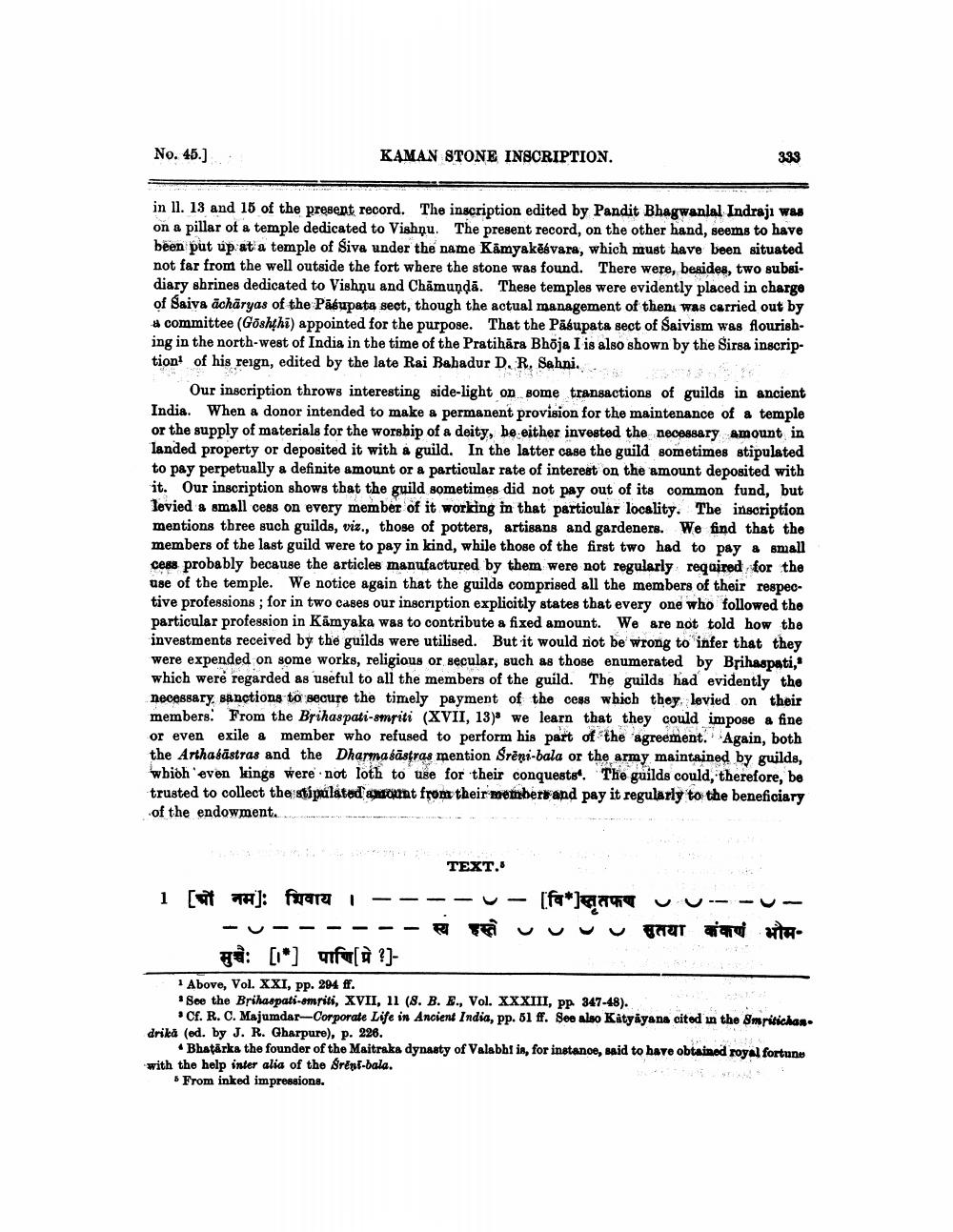________________
No. 45.)
KAMAN STONE INSCRIPTION.
333
in 11. 13 and 15 of the present record. The inscription edited by Pandit Bhagwanlal Indraji was on a pillar of a temple dedicated to Vishnu. The present record, on the other hand, seems to have been put up at a temple of Siva under the name Kamyakēsvara, which must have been situated not far from the well outside the fort where the stone was found. There were, besides, two subsidiary shrines dedicated to Vishnu and Chāmundā. These temples were evidently placed in charge of Saiva acharyas of the Pābupata sect, though the actual management of then was carried out by # committee (Goshthi) appointed for the purpose. That the Pasupata sect of Saivism was flourishing in the north-west of India in the time of the Pratihāra Bhāja I is also shown by the Sirsa inscription of his reign, edited by the late Rai Bahadur D.R. Sahni..
Our inscription throws interesting side-light on some transactions of guilds in ancient India. When a donor intended to make a permanent provision for the maintenance of a temple or the supply of materials for the worsbip of a deity, be either invested the necessary amount in landed property or deposited it with a guild. In the latter case the guild sometimes stipulated to pay perpetually a definite amount or a particular rate of interest on the amount deposited with it. Our inscription shows that the guild sometimes did not pay out of its common fund, but levied a small cess on every member of it working in that particular locality. The inscription mentions three such guilds, viz., those of potters, artisans and gardeners. We find that the members of the last guild were to pay in kind, while those of the first two had to pay a small cess probably because the articles manufactured by them were not regularly required for the use of the temple. We notice again that the guilds comprised all the members of their respective professions ; for in two cases our inscription explicitly states that every one who followed the particular profession in Kamyaka was to contribute a fixed amount. We are not told how the investments received by the guilds were utilised. But it would not be wrong to infer that they were expended on some works, religious or secular, such as those enumerated by Brihaspati," which were regarded as useful to all the members of the guild. The guilds had evidently the necessary. sanctions to secure the timely payment of the cess which they levied on their members. From the Brihaspati-smriti (XVII, 13); we learn that they could impose a fine or even exile a member who refused to perform his part of the agreement. Again, both the Arthasāstras and the Dharmaśāstras mention Srēni-bala or the army maintained by guilds, which even kings were not loth to use for their conquests. The guilds could, therefore, be trusted to collect the stipulated amount from their members and pay it regularly to the beneficiary of the endowment....
TEXT. 1 [at Fi]: fuera I ----U- [fa*]an vu-cu-u------ R u uuu ENOT
the Fa: ["] [ ?)1 Above, Vol. XXI, pp. 294 ff. * See the Brihaspati-omriti, XVII, 11 (8. B. E., Vol. XXXIII, PP 347-48).
Cf. R. C. Majumdar-Corporate Life in Ancient India, pp. 51 ff. See also Katyayana cited in the Smritichas. drika (od. by J. R. Gharpure), p. 226.
Bhatarka the founder of the Maitraka dynasty of Valabhs in, for instance, said to have obtained royal fortune with the help inter alia of the Srini-bala.
From inked impressions.




